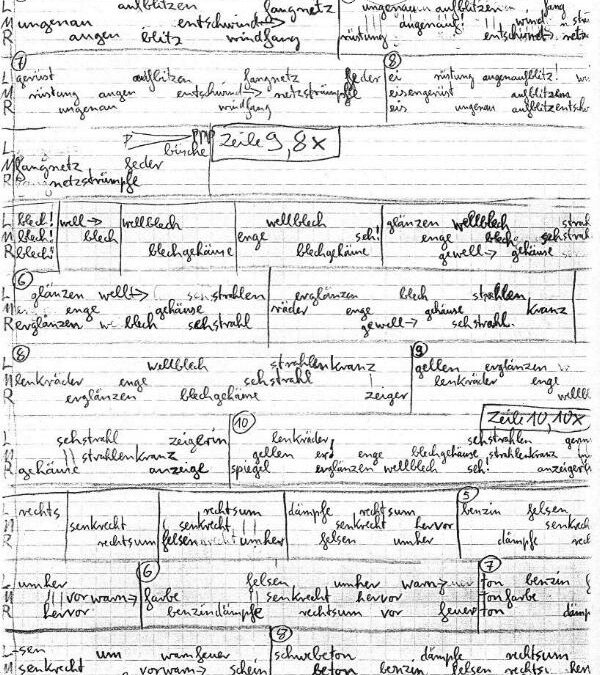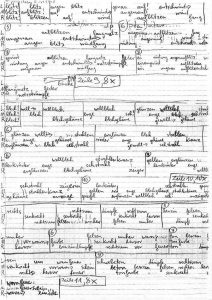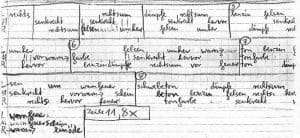A sonotopological SoundSpeechConsistencyMachine
with text lines by Konrad Bayer
Voices: Rufus Beck, Peter Fitz, Friedhelm Ptok
Composition and realization: Sabine Schäfer and Joachim Krebs
Production: SWR 2002
First broadcast: SWR 2 Radio-Art Hörspiel, October 10, 2002, 21h
Konrad Bayer (1932-1964) understood his ‘Wortverschränkungstexte’ as an attempt at a “topology of language”, in which – as in the text “flucht” – the last syllable of one word forms the first syllable of the next in an endless chain. “If one understands prose in the sense of the ‘narrative thread’ as something linear,” says Gerhard Rühm, then “Konrad Bayer with ‘flucht’ is the total proseist.” – The linear structures from this and two other texts by the Viennese experimenter Konrad Bayer become a consistency machine of language and sound in the audio piece by the composer and media artist pair <sabine schäfer // joachim krebs>, which seems self-evident but develops a highly dramatic tension.
It is precisely through the block-like and successive juxtaposition of sound and language, in the form of individual, artificially designed so-called sound and language milieus – which are interwoven at their edges in the most diverse ways, not only acoustically – that it becomes possible for the listener to perceive more clearly the “inner”, purely sonic intensities of the “SprachklangLinien” produced by the artist couple, only with the help of computer-aided, digital recording, editing and montage techniques.
In order to intensify the reception of the differentiated multidimensional spaces of the acoustic microstructures of the noise and sound materials used in this “KlangSprachKomposition” from the human environment and working world as well as from the animal and natural spheres – especially by means of the process of so-called “sound microscopy” through various sampling techniques – the use of headphones is strongly recommended by the authors.
Work-Text for ProsaPhon(ie) – a sonotopological SoundLanguageConsistencyMachine
with the text lines <flucht>, <stadt> and <der die mann> by Konrad Bayer
The sole speech sound material of the radiophonic composition ProsaPhon(ie) consists of the prose texts <flucht>, <stadt> and <der die mann>, spoken by the three actors (Peter Fitz, Friedhelm Ptock and Rufus Beck) and written in 1962 by the Austrian writer Konrad Bayer, who lived and worked in the environment of the so-called “Wiener Gruppe” around Artmann, Achleitner, Rühm and Wiener.
The autonomous literary techniques of quasi-analytical treatment of language developed by Konrad Bayer “out of skepticism about the communicative capacity of language” (Rühm) led, among other things, in Bayer’s late work (he died by suicide in 1964) to the language montage technique of word entanglement. This procedure – explicitly called “topology of language” by Bayer – is based on the principle of equality of the purely tonal part of individual words or word syllables with simultaneous ambiguity of the semantic levels of meaning.
This kind of treatment of language, especially in the prose texts <stadt> and <flucht>, with its tendency to sonify language “in itself,” shows clear affinities not only, as one might at first suppose, to Dada(ism), in which, however, semantics often appears completely dissolved in favor of the “musicalization of language.” The acceleration of the uninterruptedly flowing semantic stratifications caused by the word entanglement technique, with a simultaneous increase in the “event density” of the most diverse levels of meaning, also reveal the most diverse references to the current developments in the thoroughly rhythmicized treatment of language in the newer hip-hop scene.
Already Gerhard Rühm, the editor of Bayer’s complete works, pointed out in the appendix to the word entanglement text <flucht> the inadequacies of presenting these language (sound) consistency experiments in book form as a pure reading text. He also described Konrad Bayer’s own first attempt to present this text as a quasi-infinite spiral by placing it on a cylindrical “mobile element” (lesesäule) that rotates on its own axis and setting it in motion.
This problem of presenting the texts (and Rühm’s remark: “- if one understands prose in the sense of the ‘narrative thread’ as something linear, and this does not seem far-fetched, konrad bayer with the <flucht> is the total prosaist”) challenged us to develop, with the help of digital, multi-track speech and sound recording techniques and their processing possibilities via computer editing and sampling technology, perhaps more adequate auditory reception possibilities of the prose text lines – without false interruption by line breaks – that do more justice to the actual intentions of the author.
In doing so, it was important for us to work out the multidimensionality of the semantic textural level in order to make it appear – while at the same time consistently maintaining the continuous-one-dimensional phonetic text lines – in its multi-linear ambiguity as a changeable process of perception of the most diverse possibilities of interpretation to be performed anew by the recipient at every moment.
Thus, on the one hand, the ambivalence of the only unambiguous, semantic concept of meaning of language and, on the other hand, the potential, vegetatively-organically ambiguous semantic-consistency-line-networking possibilities – with their respective purely sonic qualities – are made experienceable and audible for the radio listener in a new way.
The production of these transparently audible, multidimensional semantic layers – while at the same time preserving the one-dimensional external form of the text lines – succeeds all the more in how the “inner sonic intensities” of language can be brought to the outside through self-dynamically generated and artistically highly artificial self-intensification loops (Loops !).
True to the sonotopological motto “to every word its place – to every sound its time”, the artificial, spatial and temporal design of the speech-sound lines is of great importance. Through the accelerated or slowed down, artistically rhythmically designed and spatially set speech-sound movement, individual “word points” mutate into vegetatively proliferating speech-sound lines floating freely in space. Meanwhile, an “intermediate plateau” permanently fluctuating between language and sound / semantics and phonetics emerges as an acoustic construction and representation matrix for the composition of such an imaginary speech-sound consistency machine.
Score excerpt with sound sample for text line 11 from <stadt> schwebetonfarbenzindämpfelsenkrechtsumhervorwarnfeuerscheinöde (Konrad Bayer, 1962)
<sabine schäfer // joachim krebs>, 2002



